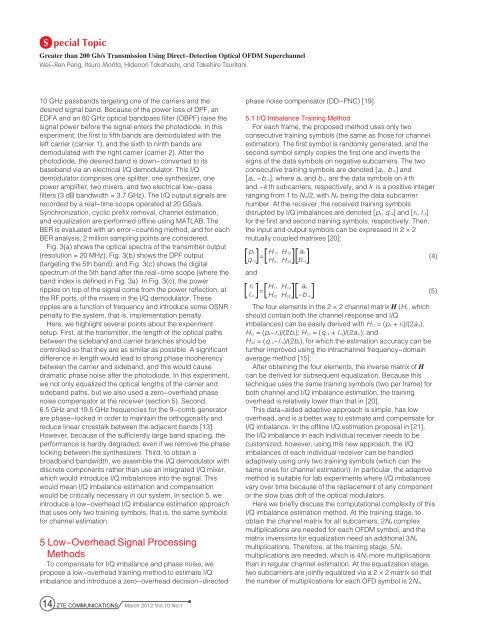ZTE Communications
ZTE Communications
ZTE Communications
You also want an ePaper? Increase the reach of your titles
YUMPU automatically turns print PDFs into web optimized ePapers that Google loves.
S pecial Topic<br />
Greater than 200 Gb/s Transmission Using Direct-Detection Optical OFDM Superchannel<br />
Wei-Ren Peng, Itsuro Morita, Hidenori Takahashi, and Takehiro Tsuritani<br />
10 GHz passbands targeting one of the carriers and the<br />
desired signal band. Because of the power loss of DPF, an<br />
EDFA and an 80 GHz optical bandpass filter (OBPF) raise the<br />
signal power before the signal enters the photodiode. In this<br />
experiment, the first to fifth bands are demodulated with the<br />
left carrier (carrier 1), and the sixth to ninth bands are<br />
demodulated with the right carrier (carrier 2). After the<br />
photodiode, the desired band is down-converted to its<br />
baseband via an electrical I/Q demodulator. This I/Q<br />
demodulator comprises one splitter, one synthesizer, one<br />
power amplifier, two mixers, and two electrical low-pass<br />
filters (3 dB bandwidth = 3.7 GHz). The I/Q output signals are<br />
recorded by a real-time scope operated at 20 GSa/s.<br />
Synchronization, cyclic prefix removal, channel estimation,<br />
and equalization are performed offline using MATLAB. The<br />
BER is evaluated with an error-counting method, and for each<br />
BER analysis, 2 million sampling points are considered.<br />
Fig. 3(a) shows the optical spectra of the transmitter output<br />
(resolution = 20 MHz); Fig. 3(b) shows the DPF output<br />
(targeting the 5th band); and Fig. 3(c) shows the digital<br />
spectrum of the 5th band after the real-time scope (where the<br />
band index is defined in Fig. 3a). In Fig. 3(c), the power<br />
ripples on top of the signal come from the power reflection, at<br />
the RF ports, of the mixers in the I/Q demodulator. These<br />
ripples are a function of frequency and introduce some OSNR<br />
penalty to the system, that is, implementation penalty.<br />
Here, we highlight several points about the experiment<br />
setup. First, at the transmitter, the length of the optical paths<br />
between the sideband and carrier branches should be<br />
controlled so that they are as similar as possible. A significant<br />
difference in length would lead to strong phase incoherency<br />
between the carrier and sideband, and this would cause<br />
dramatic phase noise after the photodiode. In this experiment,<br />
we not only equalized the optical lengths of the carrier and<br />
sideband paths, but we also used a zero-overhead phase<br />
noise compensator at the receiver (section 5). Second,<br />
6.5 GHz and 19.5 GHz frequencies for the 9-comb generator<br />
are phase-locked in order to maintain the orthogonality and<br />
reduce linear crosstalk between the adjacent bands [13].<br />
However, because of the sufficiently large band spacing, the<br />
performance is hardly degraded, even if we remove the phase<br />
locking between the synthesizers. Third, to obtain a<br />
broadband bandwidth, we assemble the I/Q demodulator with<br />
discrete components rather than use an integrated I/Q mixer,<br />
which would introduce I/Q imbalances into the signal. This<br />
would mean I/Q imbalance estimation and compensation<br />
would be critically necessary in our system. In section 5, we<br />
introduce a low-overhead I/Q imbalance estimation approach<br />
that uses only two training symbols, that is, the same symbols<br />
for channel estimation.<br />
5 Low-Overhead Signal Processing<br />
Methods<br />
To compensate for I/Q imbalance and phase noise, we<br />
propose a low-overhead training method to estimate I/Q<br />
imbalance and introduce a zero-overhead decision-directed<br />
14<br />
<strong>ZTE</strong> COMMUNICATIONS<br />
March 2012 Vol.10 No.1<br />
phase noise compensator (DD-PNC) [19].<br />
5.1 I/Q Imbalance Training Method<br />
For each frame, the proposed method uses only two<br />
consecutive training symbols (the same as those for channel<br />
estimation). The first symbol is randomly generated, and the<br />
second symbol simply copies the first one and inverts the<br />
signs of the data symbols on negative subcarriers. The two<br />
consecutive training symbols are denoted [ak, b-k] and<br />
[ak, -b-k], where ak and b-k are the data symbols on k th<br />
and -k th subcarriers, respectively, and k is a positive integer<br />
ranging from 1 to Nd/2, with Nd being the data subcarrier<br />
number. At the receiver, the received training symbols<br />
disrupted by I/Q imbalances are denoted [pk, q-k] and [rk, l-k]<br />
for the first and second training symbols, respectively. Then,<br />
the input and output symbols can be expressed in 2 × 2<br />
mutually coupled matrixes [20]:<br />
pk<br />
q-k<br />
and<br />
rk<br />
l-k<br />
H 11 H 12 ak<br />
= (4)<br />
H 21 H 22 b-k<br />
H 11 H 12 ak<br />
= (5)<br />
H 21 H 22 -b-k<br />
The four elements in the 2 × 2 channel matrix H (Hij, which<br />
should contain both the channel response and I/Q<br />
imbalances) can be easily derived with H11 = (pk + rk)/(2a k),<br />
H12 = (pk-rk)/(2bk); H 21 = (q-k + l-k)/(2a k ); and<br />
H 22 = (q-k-l-k)/(2bk), for which the estimation accuracy can be<br />
further improved using the intrachannel frequency-domain<br />
average method [15].<br />
After obtaining the four elements, the inverse matrix of H<br />
can be derived for subsequent equalization. Because this<br />
technique uses the same training symbols (two per frame) for<br />
both channel and I/Q imbalance estimation, the training<br />
overhead is relatively lower than that in [20].<br />
This data-aided adaptive approach is simple, has low<br />
overhead, and is a better way to estimate and compensate for<br />
I/Q imbalance. In the offline I/Q estimation proposal in [21],<br />
the I/Q imbalance in each individual receiver needs to be<br />
customized; however, using this new approach, the I/Q<br />
imbalances of each individual receiver can be handled<br />
adaptively using only two training symbols (which can the<br />
same ones for channel estimation). In particular, the adaptive<br />
method is suitable for lab experiments where I/Q imbalances<br />
vary over time because of the replacement of any component<br />
or the slow bias drift of the optical modulators.<br />
Here we briefly discuss the computational complexity of this<br />
I/Q imbalance estimation method. At the training stage, to<br />
obtain the channel matrix for all subcarriers, 2Nd complex<br />
multiplications are needed for each OFDM symbol, and the<br />
matrix inversions for equalization need an additional 3Nd<br />
multiplications. Therefore, at the training stage, 5Nd<br />
multiplications are needed, which is 4Nd more multiplications<br />
than in regular channel estimation. At the equalization stage,<br />
two subcarriers are jointly equalized via a 2 × 2 matrix so that<br />
the number of multiplications for each OFD symbol is 2Nd,

















